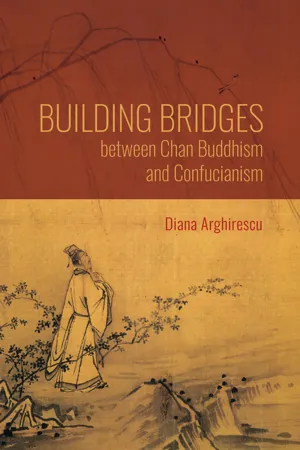
Building Bridges between Chan Buddhism and Confucianism
A Comparative Hermeneutics of Qisong's "Essays on Assisting the Teaching"
- 310 pages
- English
- ePUB (mobile friendly)
- Available on iOS & Android
Building Bridges between Chan Buddhism and Confucianism
A Comparative Hermeneutics of Qisong's "Essays on Assisting the Teaching"
About This Book
In Building Bridges between Chan Buddhism and Confucianism, Diana Arghirescu explores the close connections between Buddhism and Confucianism during China's Song period (960–1279). Drawing on In Essays on Assisting the Teaching written by Chan monk-scholar Qisong (1007–1072), Arghirescu examines the influences between the two traditions. In his writings, Qisong made the first substantial efforts to compare the major dimensions of Confucian and Chan Buddhist thought from a philosophical view, seeking to establish a meaningful and influential intellectual and ethical bridge between them.
Arghirescu meticulously reveals a "Confucianized" dimension of Qisong's thought, showing how he revisited and reinterpreted Confucian terminology in his special form of Chan aimed at his contemporary Confucian readers and auditors "who do not know Buddhism." Qisong's form of eleventh-century Chan, she argues, is unique in its cohesive or nondual perspective on Chinese Buddhist, Confucian, and other philosophical traditions, which considers all of them to be interdependent and to share a common root.
Building Bridges between Chan Buddhism and Confucianism is the first book to identify, examine, and expand on a series of Confucian concepts and virtues that were specifically identified and discussed from a Buddhist perspective by a historical Buddhist writer. It represents a major contribution in the comparative understanding of both traditions.
Frequently asked questions
Information
Table of contents
- Cover
- Title Page
- Copyright
- Contents
- Acknowledgments
- Abbreviations and Conventions
- Introduction
- 1. Chan Scholar-Monk Qisong on the Affinities and Differences between Chan Buddhism and Confucianism in “Inquiry into the Teachings” (“Yuanjiao” 原教)
- 2. An Eleventh-Century Confucianized and Cohesive Form of Chan: Qisong’s Interpretation of “Teaching” (Jiao 教) in the “Extensive Inquiry into the Teachings” (“Guang yuanjiao” 廣原教)
- 3. Qisong’s “Letter of Advice” (“Quanshu” 勸書): An Examination and Correction of the Deficiencies of Confucianism
- 4. Qisong on Buddhist Filial Devotion (Xiao 孝): A Buddhist-Confucian Comparative Perspective
- 5. Heart-Mind (Xin 心), Emotions (Qing 情), and Nature-Emptiness (Xing 性) in Qisong’s Thought: A Song-Dynasty Interpretation of Cohesive Chan Practice Intended for Confucian Scholars
- 6. Qisong on Universal Principle (Li 理), Nothingness (Wu 無), and the “Encomium of the Platform Sutra” (“Tanjing zan” 壇經贊): Answers avant la Lettre to Zhu Xi’s Twelfth-Century Criticism
- 7. Ethico-Spiritual Discipline, Emotions, and Behavior during the Song Dynasty: Zhu Xi’s and Qisong’s Commentaries on the Zhongyong in Comparative Perspective
- Conclusion
- Notes
- Bibliography
- Index
- About the Author